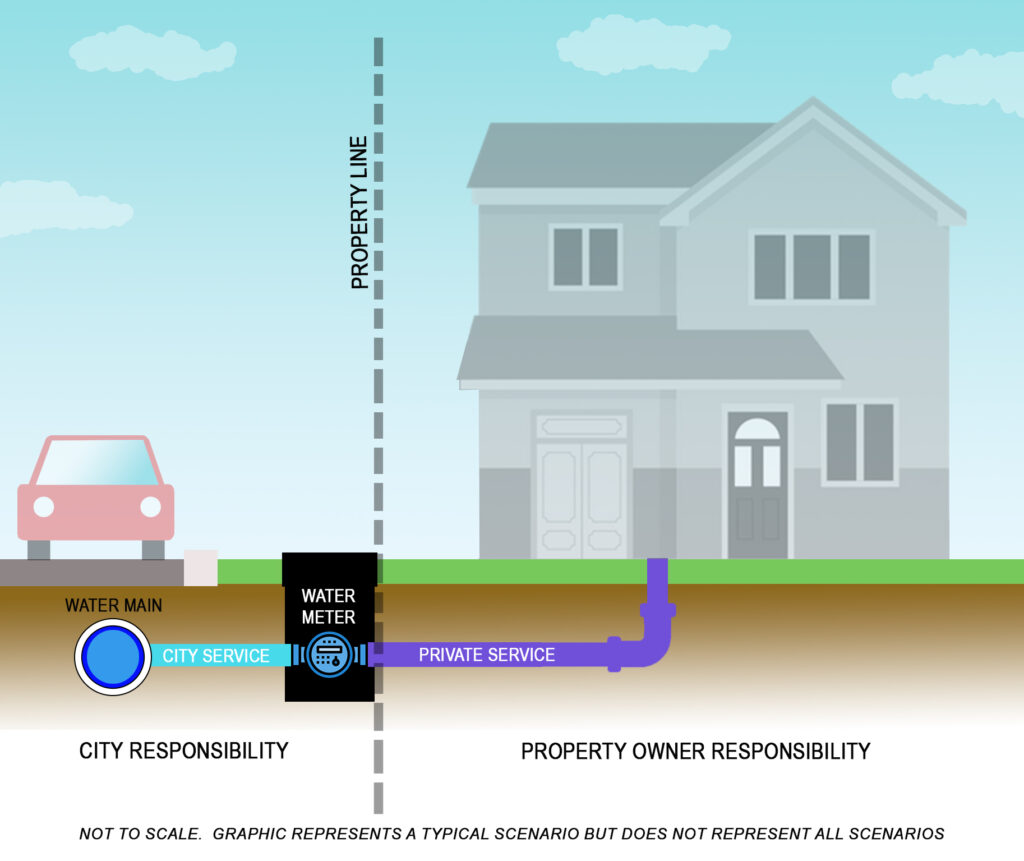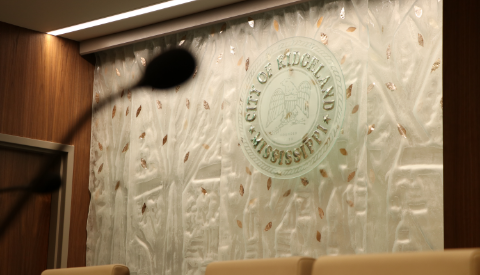Water Service Line Information
Help Make Ridgeland Lead-Free
Safe drinking water is a top priority for the City of Ridgeland. The City of Ridgeland is focused on protecting the health of every household in our community. The water found in the City of Ridgeland’s distribution system is free from lead from the time it leaves the City’s water supply wells and storage tanks until it arrives at the customer’s water tap. However, clean drinking water can be contaminated with lead as it flows through lead service lines, pipes and plumbing in and around your home. Protecting drinking water from lead sources is the shared responsibility of the City of Ridgeland and the property owner. The water service line is the pipe that connects the public water supply to a building. The service line has a designated “public” and “private” side that is divided by the water meter. The City of Ridgeland maintains the “public” service line between the water main and the water meter that is located in a public space such as City right-of-way or an easement. The property owner maintains the “private” service line located between the water meter and the building.

Water Service Line Inventory
Knowing the locations of all lead service lines is the first step to ensuring they are replaced. The City of Ridgeland has collected pipe material data for water service lines throughout the City. This pipe material data is based on a range of sources with varying degrees of accuracy. Our most accurate data comes from the City of Ridgeland water department’s field notes from completed work orders. Other service line pipe material data sources include permit records, water main tap records, meter installation records, tax assessor records, and construction drawings. Ridgeland estimates that there are currently no lead service lines on the public side of the system; however, there are service lines in the City that we have labeled as UNKNOWN because we have not yet verified the material for either the city service side, the private service side, or both. If a service line is labeled as UNKNOWN, there is the potential that some or all of the service line could be made of lead or galvanized pipe that was previously connected to lead. People living in homes with a lead or galvanized pipe previously connected to a lead service line have an increased risk of exposure to lead from their drinking water. You can use our WATER SERVICE LINE MAP to see what information the city currently has for your service lines.
Here is your guide to the Water Service Line Map map:
Each water customer is identified on the map as a circle. Each circle is divided into two halves. The left side of the circle is the public service pipe material, and the right side is the private service pipe material.

GREEN indicates that the city has identified the service line as PLASTIC. This means Ridgeland’s inventory has a record from a reliable data source (field identified, construction drawings, service records, or year installed) confirming your water service line material.
BROWN indicates that the city has identified the service line as COPPER. This means Ridgeland’s inventory has a record from a reliable data source (field identified, construction drawings, service records, or year installed) confirming your water service line material.
BLUE indicates that the city has identified the service line as GALVANIZED. This means Ridgeland’s inventory has a record from a reliable data source (field identified, construction drawings, service records, or year installed) confirming your water service line material.
WHITE indicates that the city has identified the service line as NOT LEAD. This means Ridgeland’s inventory has a record from a reliable data source (construction drawings, service records, or year installed) confirming your water service line material is NOT LEAD.
RED indicates that the pipe type is UNKNOWN at your property.
Click the Map below to view your service line information

Next Steps
The City of Ridgeland will initiate and conduct a “dig and determine” test pit of all UNKNOWN public service line pipes in order to confirm the pipe material. If the public service line is lead, it will be replaced. If the City of Ridgeland identifies and determines that the private service line is lead, the property owner will be contacted. The majority of the UNKNOWN service lines are located within the older areas of the City and/or located at a home built prior to 1960. While we don’t anticipate either service line being lead, we want to ensure our customers that lead is not present so we will field verify at these locations.
Identify your Pipe Material and Help us Update our Records
You can identify your pipe material by checking your household water service connection inside the water meter box, typically located outside of your home. The private service line will be the line that runs from the water meter to your home (see the diagram at the beginning of this article). You can also contact a licensed plumber to inspect your pipes, fittings, and fixtures inside and outside your home to determine if lead pipes or fittings are present. If you are able to determine the material of your service line, please take a photograph of the material and call Public Works at 601-853-2027, and we will guide you through the pipe ID submittal process. If you believe that our records for your property are incorrect or would like to acknowledge that we have correctly identified your pipe material, please contact us so we can update our records accordingly.

Image courtesy of DC Water
If you need more information, help identifying your service line pipe material, or have any other questions, please call Public Works at 601-853-2027.
What are other sources of LEAD in drinking water?
The City’s water supply is virtually lead-free as it travels through the City’s distribution system and water mains in the ground. Clean water can come in contact with lead as it flows through the service lines, plumbing pipes, plumbing fittings, and fixtures in and around your home. Lead service lines were predominately installed prior to the mid-1950s in areas around the United States. The most common lead source in drinking water is lead pipes; lead welding solder, household plumbing fixtures, and some plumbing pipe fittings made prior to 1986 may also contain lead.
Lead Solder – Lead solder connects pipes in household plumbing. Until 1987, it was used in household plumbing. If your house was built before 1987, its plumbing may have had lead solder.
Brass Faucets, Valves, and Fittings – Almost all faucets, valves, and fittings have brass components, which may contain lead. Until 2014, brass faucets and fittings sold in the United States and labeled “lead-free” could contain up to eight percent lead. Brass service lines may also contain lead. Effective January 2014, the Reduction of Lead in Drinking Water Act specifies that these materials may not contain more than 0.25 percent lead.
Galvanized Iron Pipes – Household galvanized pipes are old, corroded pipes that were installed in many homes before the 1960s. These pipes can release lead in water if the property has, or previously had, a lead service pipe. Galvanized pipes are made with a protective layer of zinc. However, the zinc layer erodes over time and results in corrosion. When lead is released from a lead service pipe and passes through galvanized plumbing, lead can accumulate on the inside, corroded walls of this plumbing. Lead release from galvanized pipes can vary from home to home and can continue to occur even after a lead service pipe is replaced.
Click on the image below for EPA’s infographic regarding lead in drinking water. Learn basic information about sources of lead in drinking water, suggestions for reducing exposure, and information about replacing lead service lines.

How do I know if my plumbing fittings and fixtures are lead free?






